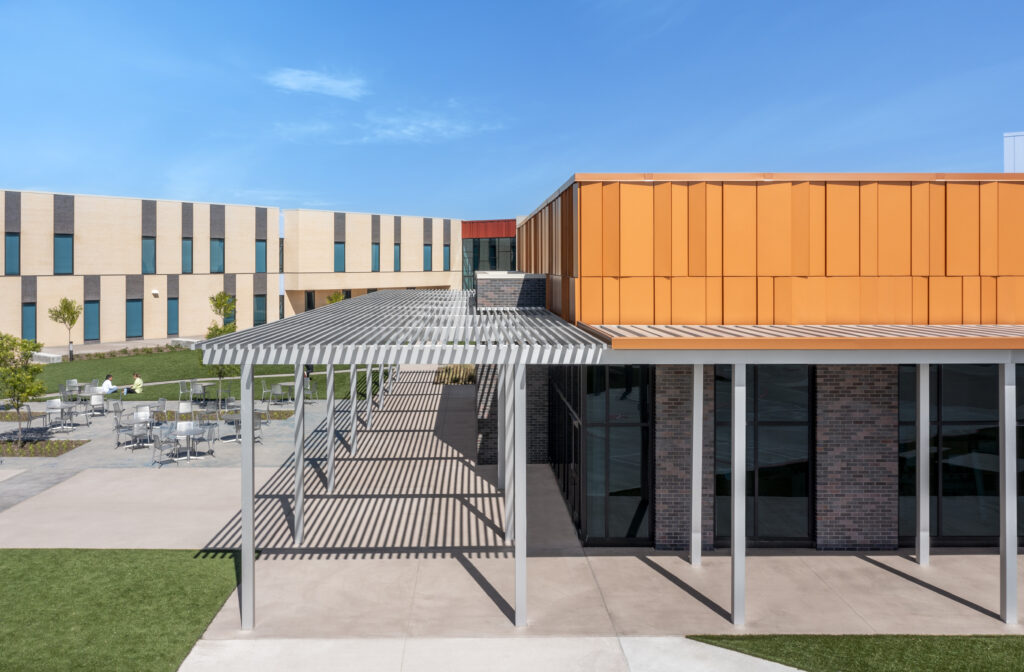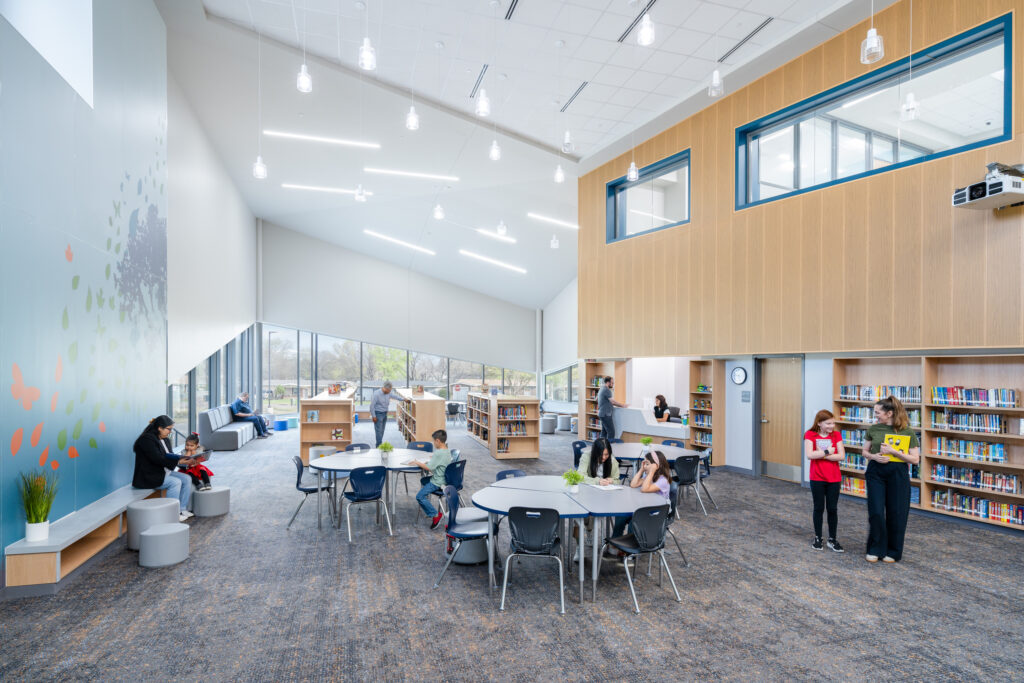K-12 public school systems are struggling to keep up with the need to modernize outdated infrastructure across the country. Limited school funding and on-going systemic disruptions from the COVID pandemic put additional pressure on school systems. In 2021, over half of US school districts reported a need to update or replace their building infrastructure. While the federal government poured $122 billion into elementary and secondary schools in 2024 alone, historically, less than 1% of funds spent on capital improvements comes from federal investment dollars.

The quality and design of school facilities impacts student activities, behaviors, and achievements. We also know disparities in positive educational outcomes are exacerbated by access to funding and poor environmental conditions. An early study found that when students live close to an airport they consistently perform worse than their peers who are not affected by nearby aircraft noise.
Even though the school design industry has come to understand the negative impacts inadequate school facilities can have on children, we have not done enough to ensure that school districts are adequately and equitably investing in environments that enhance learning and well-being outcomes. Alongside our call for action to invest more dollars into our crumbling schools, we are also raising a call for accountability from the design industry to make the best use of those dollars by prioritizing evidence-based design solutions that can positively impact, augment, and support teaching and learning.

The Shortcomings of POE Tools: What We Measure Matters
Post occupancy evaluations (POEs) are design research studies that evaluate the performance of built projects, and they are not new to K-12 learning environments. Back in 2014, researchers in Australia published a comprehensive review of approaches and methods for evaluating K-12 learning environments. In the decade since their review, however, little has changed about the way we regularly and systematically evaluate K-12 designs. Even though we often design school environments with innovative pedagogies in mind, we rarely evaluate our learning spaces with an eye toward how design interventions truly support teaching and learning strategies.
A number of POE tools exist, but widespread agreement and adoption of particular tools and methods are lagging industry wide. To better understand how the design strategies we implement in K-12 schools are supporting the teaching strategies that take place in those buildings, we need a standardized tool – one that is broadly adopted and better equipped to make the case for evidence-based school design. We must go beyond measuring environmental satisfaction or comfort: we must find consistent and reliable ways to measure the functional performance of our learning and teaching environments.
Environmental Satisfaction is a self-report measure that tends to focus on how an end-user “likes” their physical environment. Importantly, environmental satisfaction can be used as a diagnostic to identify under-performing aspects of schools, but it is insufficient for understanding the full impact of school design. A comprehensive measure that links design intent to perceptions of functionality is essential for a more holistic assessment. This link is crucial for us to be able to answer big questions around how the built environment can support teaching and learning.

Aligning Design Intent with Functional Performance
Every teacher in every school in every district in every state likely has their own ideas and approach to effective teaching. Designers of learning environments are challenged with creating spaces that support this diversity of teaching strategies and the commonalities among them. Those environments are not just positively impacting the teaching experience, but the learner’s experience too.
Imagine a school that incorporates transparent, operable walls between classrooms. The design intent is to enable collaborative learning and knowledge sharing. A POE showed high environmental satisfaction scores for flexibility. However, the walls were rarely used as intended. Teachers found them difficult to operate and disruptive to class activities; they required extra work to collaborate with their neighboring teachers. As a result, teachers couldn’t meet their collaborative learning goals and in fact, had negative outcomes related to knowledge sharing. This theoretical example demonstrates how narrow satisfaction criteria don’t properly reflect functionality or design outcomes.
School environments are often evaluated based on general satisfaction or comfort surveys, without considering how the design directly supports common teaching methods like differentiated learning, project-based learning, or self-directed learning. These evaluations may capture how much teachers and students “like” the space but completely ignore whether it helps or hinders education. As a result, an evaluation may be positive despite critical design elements not functioning as intended, such as emotional regulation spaces that remain unused or technology integrations that are cumbersome. Without measuring whether design strategies are meeting their intended purpose, we are missing out on understanding how potential use of space is misaligned with the actual use of space.

Developing a Comprehensive Measurement Tool
In 2023, researchers at HKS, Multistudio, Perkins & Will, and Austin Independent School District came together to solve this problem together, forming CAUSE, the Coalition for the Advanced Understanding of School Environments. We at CAUSE believe in the power of the built environment to improve the learning and teaching experience in our schools, but we desperately need measurement strategies that are shared, credible, and easy to deploy. Housed within the Center for Advanced Design Research and Evaluation (CADRE), a research nonprofit with the goal of improving the health and well-being of communities, CAUSE is piloting a POE tool that measures student and teacher outcomes and aligns teaching method with how supportive the physical environment is of those behaviors.
The vast majority of published POEs are simply comparing non-modernized to modernized schools. Due to the complex and evolving nature of school renovation and new construction, it can be challenging to do more than this within one given study. By sharing metrics, we will all be able to ask bigger, more specific questions and ultimately make more informed and evidence-based decisions in school design.
Join the CAUSE at EDspaces this Fall or reach out to CAUSE@cadreresearch.org to discuss how you can get involved with this collaborative, open-source, and open-science endeavor to standardize occupancy evaluations for K-12 schools.
Learn more by attending the session: Join the CAUSE: Industry Coalition Standardizing K-12 Post Occupancy Evaluation on Tuesday, November 12 at 2:30 pm in Classroom 370 BCEF | Multistudio + MUZO during EDspaces in Houston. Not registered for EDspaces? Register here.

